
Hot springs of Matouba
14 points of interest
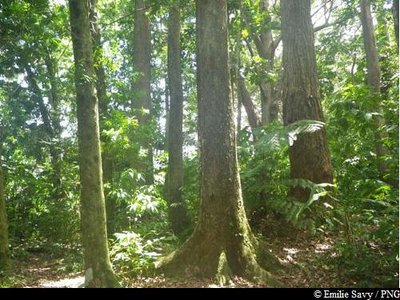
plantation d'Eucalyptus - Emilie Savy / PNG  Flora
FloraEucalyptus
Members of the Myrtaceae family, Eucalyptus trees were originally imported from Australia. They prosper in moist and acidic soil. The bark comes off in patches and the tree exudes a resinous gum when damaged.
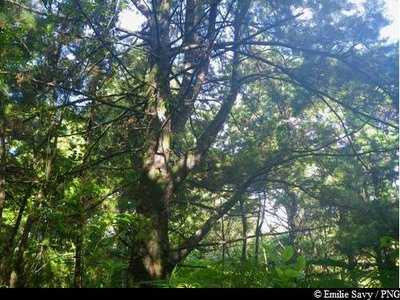
Cyprès - Emilie Savy / PNG  Flora
FloraCyprus trees
The cypress tree belongs to the Cupressaceae family. With an easily recognisable smell, this tree was introduced to Guadeloupe as an ornamental species.
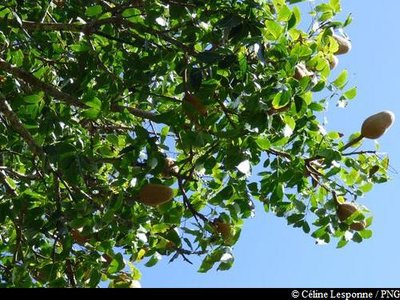
 Flora
FloraWest Indian Mahogany
The West Indian Mahogany (Swietennia macrophylla) belongs to the Meliaceae family. It is a perennial tree with a large, upright, cylindrical bole and small, yellow-green flowers. This species - highly prized by woodworkers on account of its hardness and colouration - was introduced for the purposes of producing timber, leading to the tree being overexploited in its area of origin. It is listed in Appendix II of the threatened species covered by the Washington Convention.
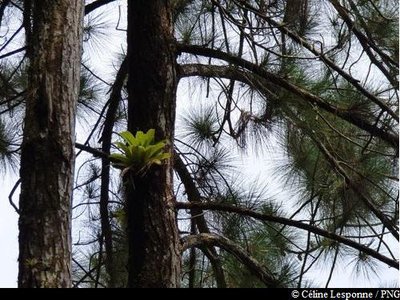
PNG  Flora
FloraCaribbean pine
The Caribbean pine (Pinus caribeae) is a member of the Pinaceae family. Now considered an invasive species in Guadeloupe, this tree was introduced so that its wood could be used as timber. It has noticeably cracked, reddish-brown bark, while the inner bark is highly resinous. It has a slender top which is shaped like a rounded pyramid.
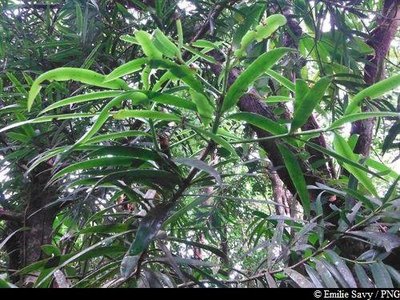
E.Savy - PNG  Flora
FloraThe Yucca Plum Pine
A member of the Podocarpaceae family, the Yucca Plum Pine (Podocarpus coriaceus) is also known locally as the "Wood rose". Closely related to conifers, it is an average-sized tree, with leathery leaves that are dark green on top and similar to an oleander's. Its brown-coloured seeds in their floral buds are particularly eye-catching. It has a thin layer of bark. This species flowers mainly in December/January, with inconspicuous flowers.
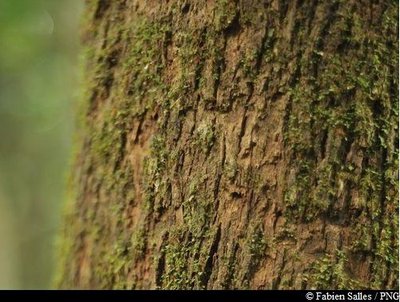
Bois bandé (détail écorce) - Fabien Salles / PNG  Flora
Flora"Bwa bandé"
Richeria grandis belongs to the Phyllanthaceae family. It is a large variety, distinctive for its tough leaves and reddish-brown bark that so often falls victim to rogue extraction. Also known as bwa bandé in Créole, it is renowned for its aphrodisiac qualities. Its wood is used as timber or in carpentry. It has very distinctive, green, grape-like fruits which form small pods and form copiously on its branches.
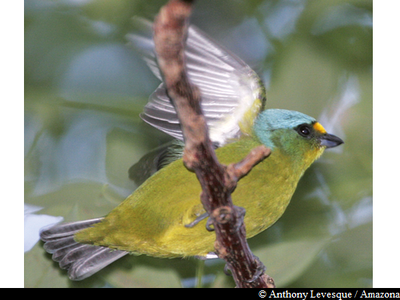
Organiste Louis D'Or - Anthony Levesque / Amazona  Fauna
FaunaAntillean euphonia
The Antillean euphonia (Euphonia musica) is also known as Douvan nwèl in Creole. The bird is distinctive for its bright blue crown and neck, while its cheeks are a darker shade of blue/green. It has a bright yellow breast and chin. Its back is olive and green, while its belly is yellow/green. This sedentary nesting bird is not very common in Guadeloupe, but it is found in the rainforest at medium altitude. It is on the IUCN Red List and is one of the species on to make the list of nesting birds in Guadeloupe.
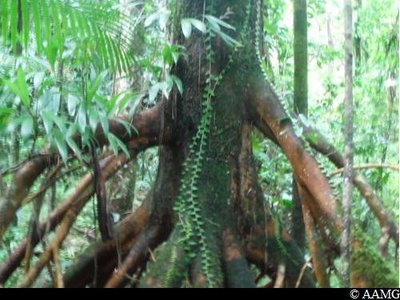
Patétuvier jaune - AAMG  Flora
FloraCandlewood
Symphonia globulifera, also commonly known as the chewstick tree, belongs to the Clusiaceae family. The tree grows in thick, humid and swampy forests. Reaching up to 25-30 metres in height, it has stilt roots and a yellow latex trunk. Its flowers are formed of bright red petals, while its fruits resemble nutmeg, are oval in shape and yellow when ripe. It wood was one used as timber for houses and resin for boats.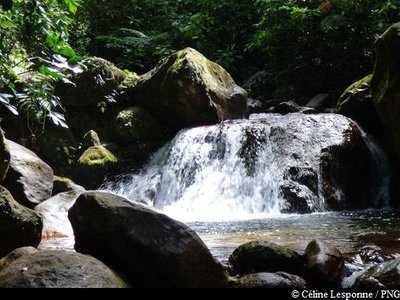
cascade sur la Rivière Rouge - Céline Lesponne / PNG  River and waterfall
River and waterfallwaterfall on the Rivière Rouge
Crossing of the Rivière Rouge, known for its cool waters. There is a fine waterfall just above.
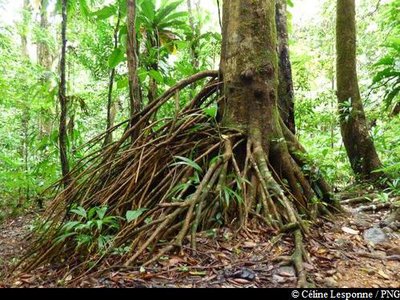
Palétuvier jaune - Céline Lesponne / PNG  Flora
FloraSymphonia globulifera and gommiers
A walk between a beautiful Symphonia globulifera tree and two specimens of gommier. The gommier (Dacryodes excelsa) can grow up to 35 metres tall. When they are damaged, its white trunk and roots exude a white resin with a pungent turpentine smell, which is traditionally used as incense or as kindle-wood, because it burns slowly regardless of the surrounding humidity. It is strictly forbidden to remove any plant parts from the National Park. Its trunk was used by American Indians to make their canoes (kanawa), and is still used today by coastal people from many tropical countries, such as Dominique, to craft fishing vessels. The tree's seeds are a favoured food with pigeons.
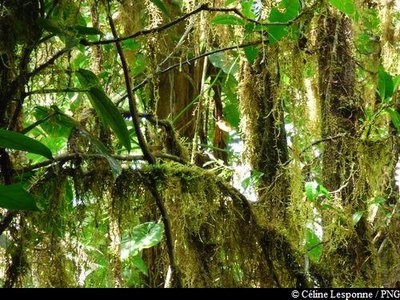
"cheveux d'ange" - Céline Lesponne / PNG  Flora
Flora"Cheveux d'ange"
These lichens are known as "Cheveux d'ange", which translates from French as "Angel's hair". They use other plants as support.

Bois cotelette noir - Céline Lesponne / PNG  Flora
Flora
point de vue - Céline Lesponne / PNG  Viewpoint
ViewpointViewpoint
An immaculate view of la Grande Découverte towards the north.
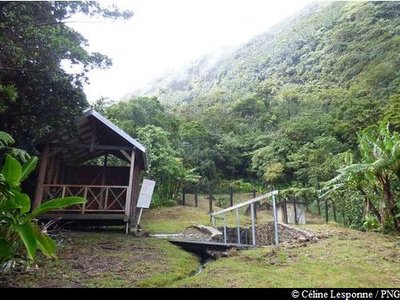
le site des Bains Chauds - Céline Lesponne / PNG  Area of relaxation
Area of relaxationHot springs area of Matouba
These sulphurous waters are just one of the many hot springs to flow out at the La Soufrière massif. They are formed by rainwater, which becomes laden with volcanic materials when it passes through the soils. The sources of this spring are used by the Matouba private hospital, which specialises in ENT care, rheumatism and skin conditions. Some of the water is used to power the on-site outdoor showers. The water temperature is around 40°C.
Description
Hiking trail colour: yellow
Take the trail that starts from the initial information board. The trail begins with a steady climb among the tall trees of the rainforest. Cross the Madame François ravine and then continue the trail. Turn right at the intersection. Cross the ravine once more. The hike continues through a wide path under the forest canopy. At the next intersection, leave the Victor Hugues trail and turn right towards the Matouba hot springs. The path then becomes progressively narrower. After walking for a short while, cross the Rivière Rouge. Continue on the path uphill. Signs are few and far between at this stage, so keep an eye out for them. The trail winds its way through the forest and eventually stops at an intersection. Leave the trail joining "Papaye" and turn left at this intersection for the final stretch of the hike before you reach the hot springs. After taking some time to enjoy the site, start your descent back. Soon after you begin your return journey, keep a beady eye out: where you see a water intake pipe (Point 1), take the path that heads to the right. Continue your journey back and return to the parking area. You may also wish to take a refreshing break at the Rivière Rouge. Before the end of the trail, take the unmarked path heading left just before the parking area in the same direction as the return path.
N.B. At the start of the forest house, the National Forestry Office offers a "Sylvascope" guide to help you understand the path. Featuring some interesting trivia about the environment, this audio guide allows you to discover the forest in more detail. Numbered information markers along the path correspond to relevant audio on the device. Return the guides to the Gourbeyre National Forestry Office Sylvathèque before heading to Matouba. For more information, contact the Forestry Office on 0590 81 37 57 or 0590 99 28 99. You can now download the Sylvascope app directly on Google Play and Apple.
- Departure : Matouba forest house, Saint-Claude
- Arrival : Matouba forest house, Saint-Claude
- Towns crossed : Saint-Claude
Altimetric profile
Recommandations
As Guadeloupe is prone to natural risks, extra care should be taken in this natural environment. For the benefit of all hikers, responsible behaviour is very important.
Make sure you adhere to any rules issued by the Regional Health Agency concerning hot baths.
Please note : the parking area is not supervised.
Information desks
Headquarters of the National Park of Guadeloupe
Montéran, 97120 Saint-Claude
The reception and shop are open to the public :
- Monday, Tuesday and Thursday : 8 am to 12.30 pm and 2 pm to 5 pm.
- Wednesday : from 8 am to 1 pm.
- Friday : 8 am to 12.30 pm.
Services : reception, shop, toilets, free parking. Building accessible to people with reduced mobility.
Localisation GPS : Lat: 16,01634 N - Lng: 61,70753 W.
Access and parking
GPS coordinates of the start point : Lat : 16,04668 N - Long : 61,69177 W.
In the village of Saint-Claude, go past the Post Office and take a left onto Avenue du Maréchal Foch. Then go past the Tourism Office and City Hall. At the stop in front of the church, turn right onto Route RN3 which leads up towards Matouba. Go past three bridges and the Rivière Rouge picnic area. Then keep going until the top of the hill. A sign showing the informative trail of Matouba will direct you to the parking on the right-hand side of the road, just before the Maison Forestière, run by the National Forestry Office.
Parking :
Source
Report a problem or an error
If you have found an error on this page or if you have noticed any problems during your hike, please report them to us here:

